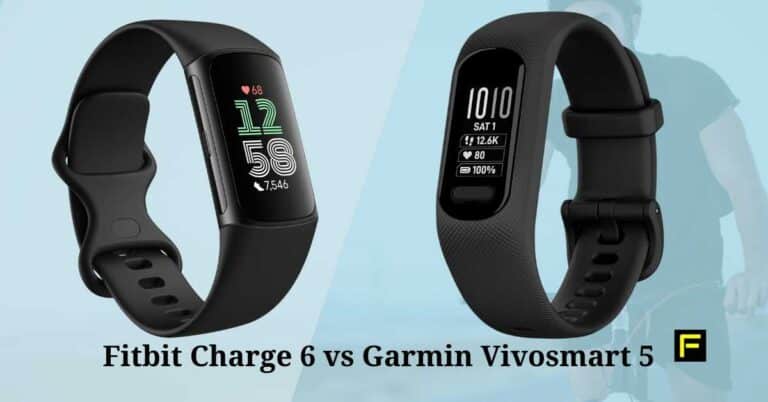Fitness trackers are the modern solution to monitoring health and activity without the need for bulky equipment or constant doctor visits. Fitbit Charge 6 vs Garmin Vivosmart 5 are both small, wearable devices that keep track of steps, heart rate, and sleep patterns, and many even provide personalized feedback to help improve overall health.
** I may earn a commission when you purchase through a link on this page. **
As wellness and fitness become more intertwined with technology, the market for these gadgets has grown, with brands like Fitbit and Garmin leading the pack with their innovative designs and features.
When it comes to choosing the right fitness tracker, potential buyers are met with a plethora of options, each with its own set of unique features.
Among these options, the Fitbit Charge 6 and Garmin Vivosmart 5 stand out for their blend of functionality and convenience.

Consumers looking for a reliable fitness tracker must consider several factors such as accuracy of health monitoring, battery life, comfort, ease of use, and the companion app experience. Given the diversity in lifestyles and preferences, identifying which features resonate with your personal goals and daily routines is paramount.
Critical elements like the fitness tracker’s sensor accuracy, water resistance, compatibility with other devices, and the ability to track multiple types of physical activity should weigh heavily in the decision-making process.

The durability of the band, visibility of the screen in various lighting conditions, and the responsiveness of the user interface are notable considerations too.
Choosing the Fitbit Charge 6 or Garmin Vivosmart 5 depends on a discerning look at these factors. Both models promise to enhance the fitness tracking experience, but they do so in their ways. It’s about finding which device aligns with personal health goals and lifestyle needs.
We’ve taken the time to compare these two fitness trackers in-depth, scrutinizing each feature to determine which one might be the best fit for your active life.
Fitbit Charge 6 vs Garmin Vivosmart 5
In the search for the ideal fitness tracker, we’ve focused on comparing the Fitbit Charge 6 and the Garmin Vivosmart 5.
We understand that choosing the right device is crucial for monitoring your daily activities and enhancing your workouts. Our comparison of these sought-after models aims to help you find the tracker that suits your lifestyle and fitness goals.
Fitbit Charge 6

If you’re looking for detailed insights into your health and fitness, the Fitbit Charge 6 is a solid pick with its advanced tracking features.
Pros
- Comprehensive health tracking with ECG and sleep monitoring
- Versatile connectivity with app notifications and contactless payments
- Weeklong battery life reduces frequent charging hassles
Cons
- No altimeter to track elevation changes
- GPS can sometimes be inconsistent
- Higher price point compared to other models
As frequent fitness enthusiasts, we’ve found that the Fitbit Charge 6’s improved heart rate sensors are noticeably more precise during our workouts.

When we took our sessions outdoors, having Google Maps on our wrists ensured we never missed a turn on our runs.
Being able to measure our oxygen saturation levels after an intense cardio session was also reassuring, making it feel like we had a personal health monitor at all times.
We particularly enjoyed the seamless integration with our smartphones. Receiving notifications and controlling music without having to reach for our phone each time was a significant advantage—especially mid-workout.

However, we did notice the occasional hiccup with GPS tracking, which sometimes took a bit longer to lock onto a signal than we would like.
Additionally, the mindfulness session feature became a favorite when winding down after a workout to ensure we’re not only working on our physical but also mental well-being.
Despite this, the inclusion of a built-in GPS meant we could leave our phones at home, which was a liberating experience.
The durability and water resistance allowed us to track our swimming sessions just as effortlessly as a run, rain, or shine.
To sum it up, the Fitbit Charge 6 stands out for its robust feature set that caters to a range of health monitoring and connectivity needs, justifying its premium position in the market.
Garmin Vivosmart 5

In our hands-on use, we found the Garmin Vivosmart 5 to be a dependable choice for those prioritizing a no-frills, health-centric tracker.
Pros
- Highly comfortable and discreet design, suitable for all-day wear
- Extensive health tracking features including stress and sleep monitoring
- Reliable battery life, lasting seamlessly throughout a week
Cons
- Lacks built-in GPS, relies on phone connection for tracking distance
- Some may find the interface less intuitive, requiring initial familiarization
- Limited smartwatch features in comparison to competitors
When we first set up the Garmin Vivosmart 5, it struck us with its comfortable fit and simple, yet effective design.

It seems to entwine seamlessly with daily life, not overwhelming us with features but providing just enough to keep us informed and proactive about our health.
Throughout the week, our experience remained consistent. The sleep metrics felt spot-on, giving us deeper insight into our sleep patterns. The battery life held up impressively well, sparing us the hassle of frequent charging.

The dependency on the phone for GPS tracking can be a drawback during outdoor fitness activities.
Also, if you’re new to Garmin’s ecosystem, there’s a slight learning curve for the interface.
Despite this, once we got the hang of it, navigating through the various health stats became second nature.
The Garmin Vivosmart 5 serves us well as a fitness tracker with a strong focus on health metrics. It’s reliable for everyday wear and provides valuable insights into our personal wellness journeys.
Fitbit Charge 6 vs Garmin Vivosmart 5
Buying Guide
Key Features to Consider
Before choosing a fitness tracker, it’s essential to evaluate key features that fit our individual needs and lifestyle. We need to decide what’s important to us, whether it’s step tracking, heart rate monitoring, or GPS capabilities.
- GPS Enabled: Yes, with turn-by-turn directions from Google Maps.
- Battery Life: Up to 7 days.
- Mindful Breathing: Yes, as part of its stress management features.
- Water Rating: Not explicitly mentioned, but Fitbit devices are designed to be water-resistant for everyday use and exercise routines that involve water.
- Sleep Tracking: Yes, with a personalized Sleep Score.
- Smart Notifications: Yes, for calls, texts, calendar, and app notifications.
- Maps: Yes, with Google Maps for turn-by-turn directions.
- Payment Options: Yes, with Google Wallet.
- Music Control: Yes, with YouTube Music controls.
- Safety & Tracking: EDA sensor shares how your body is responding to stress.
- Heart Rate: Yes, with the most accurate heart rate tracking on a Fitbit tracker.
- Wake Up Mode: Not explicitly mentioned, but includes features like silent alarms sleep tracking, which can be used to wake you without a loud alarm.
- Warranty: 1-year limited warranty on devices and accessories.
Garmin Vivosmart 5– Features
- GPS Enabled: Uses your phone’s GPS to track distance and pace during outdoor activities.
- Battery Life: Up to 7 days.
- Mindful Breathing: Yes, includes a breathwork activity profile.
This feature helps you focus on your breathing to reduce stress. - Water Rating: It has a 5ATM water-resistance rating. You can wear it while swimming or showering.
- Sleep Tracking: Yes, automatically tracks your sleep patterns and stages. Provides a sleep score to assess sleep quality.
- Smart Notifications: Yes, for calls, texts, and app notifications.
- Maps: Relies on a connected smartphone for GPS data.
- Music Control: You can play, pause, and skip tracks directly from the tracker.
- Safety & Tracking: Includes emergency assistance features. Can send your location to emergency contacts if needed.
- Heart Rate: Yes, monitors heart rate 24/7. Tracks resting heart rate and during activities.
- Wake Up Mode: No specific wake-up mode mentioned. Includes alarms and alerts that can be set via the Garmin Connect app.
- Warranty: 1-year limited warranty on devices and accessories.
Frequently Asked Questions
In this section, we tackle common queries about the Fitbit Charge 6 and Garmin Vivosmart 5 to aid in your decision-making process.
What are the key differences between the Fitbit Charge 6 and Garmin Vivosmart 5 fitness trackers?
The Fitbit Charge 6 typically offers a broader range of smart features, including voice assistance and a more vibrant display, while the Garmin Vivosmart 5 is noted for its robust build quality and GPS integration without the need for a smartphone.
How does the battery life of the Fitbit Charge 6 compare to the Garmin Vivosmart 5?
We find the Garmin Vivosmart 5 to excel with up to seven days of battery life, outlasting the Fitbit Charge 6, which typically requires a charge after about five days, depending on usage.
Which features distinguish the Garmin Vivosmart 5 from the Fitbit Charge 6 in terms of health and fitness monitoring?
The Garmin Vivosmart 5 offers comprehensive GPS tracking and a focus on sports-specific features. The Fitbit Charge 6 provides an array of health-monitoring tools such as ECG, stress management, and sleep analysis.
Can the Fitbit Charge 6 interface with more smartphone models than the Garmin Vivosmart 5?
Both trackers boast wide compatibility with Android and iOS devices, but our research shows that the Fitbit Charge 6 has a slight edge in synchronizing with a broader array of smartphone brands.
How do the Fitbit Charge 6 and Garmin Vivosmart 5 vary in their design and comfort for daily wear?
The Fitbit Charge 6 sports a sleeker design with a larger color display, which some may find more comfortable and stylish for all-day wear. In contrast, the Garmin Vivosmart 5’s design is more minimalistic and rugged, possibly appealing to those who prioritize durability.
Between the Fitbit Charge 6 and the Garmin Vivosmart 5, which offers a more user-friendly experience for tracking workouts and activities?
Our assessment shows that the Fitbit Charge 6 has an edge in user-friendliness due to its intuitive interface and seamless navigation, making workout and activity tracking straightforward even for fitness tracker newcomers.
Recommendation
After comparing the Fitbit Charge 6 and Garmin Vivosmart 5, the Charge 6 stands out for its comprehensive health tracking, built-in GPS, and smartwatch features, making it an excellent choice for tech-savvy users.
The Vivosmart 5 offers essential fitness tracking in a user-friendly package, but its value proposition is challenged by the Charge 6’s superior offerings at a similar price point.
Considering the advanced health features, durability, and additional functionalities like NFC payments and music control, the Fitbit Charge 6 provides a more compelling package for those seeking a blend of fitness tracking and lifestyle convenience.

Rick Huey is a fitness writer who has dedicated his life to living an active lifestyle. With more than 30 years of experience in the fitness industry, Rick is a respected contributor for FitFab50.com, where he shares his wealth of knowledge with a wide audience. His dedication to promoting the benefits of living an active lifestyle has inspired many people to pursue their own fitness journeys with enthusiasm and dedication.
Last update on 2024-07-24 / Affiliate links / Images from Amazon Product Advertising API

